Here’s the 2020 Tour de France guide. There’s a profile of every stage with a quick take on the day. You’ll also find reference material on the race rules like time bonuses, the points scale for the green and polka-dot jersey, time cuts and plenty more.
This is a blog post but you’ll find a permanent page on the menu at the top of the page or just remember or bookmark inrng.com/tour in case you need it for reference.

Route Summary
The map says plenty, the race sticks to France’s southern half which means more hills and mountains. This is an anti-siesta Tour course, there will still be some majestic slow moments but there are few sprint stages and the race is never far away from a tricky climb. There’s no gentle introduction, the opening weekend in Nice will be hectic, there’s a ski station summit finish on Stage 4 and there are many mid-mountain stages with Mont Aigoual, the Suc-au-May, the Puy Mary and the Grand Colombier before the final Alpine week and the final 36km time trial.
Stage 1 – Saturday 29 August

A circuit in Nice that’s reminiscent of the final stage of Paris-Nice which is often a highlight of the season. This time it’ll be different as an opener, more riders and teams with cards to play and way more hectic.
Stage 2 – Sunday 30 August
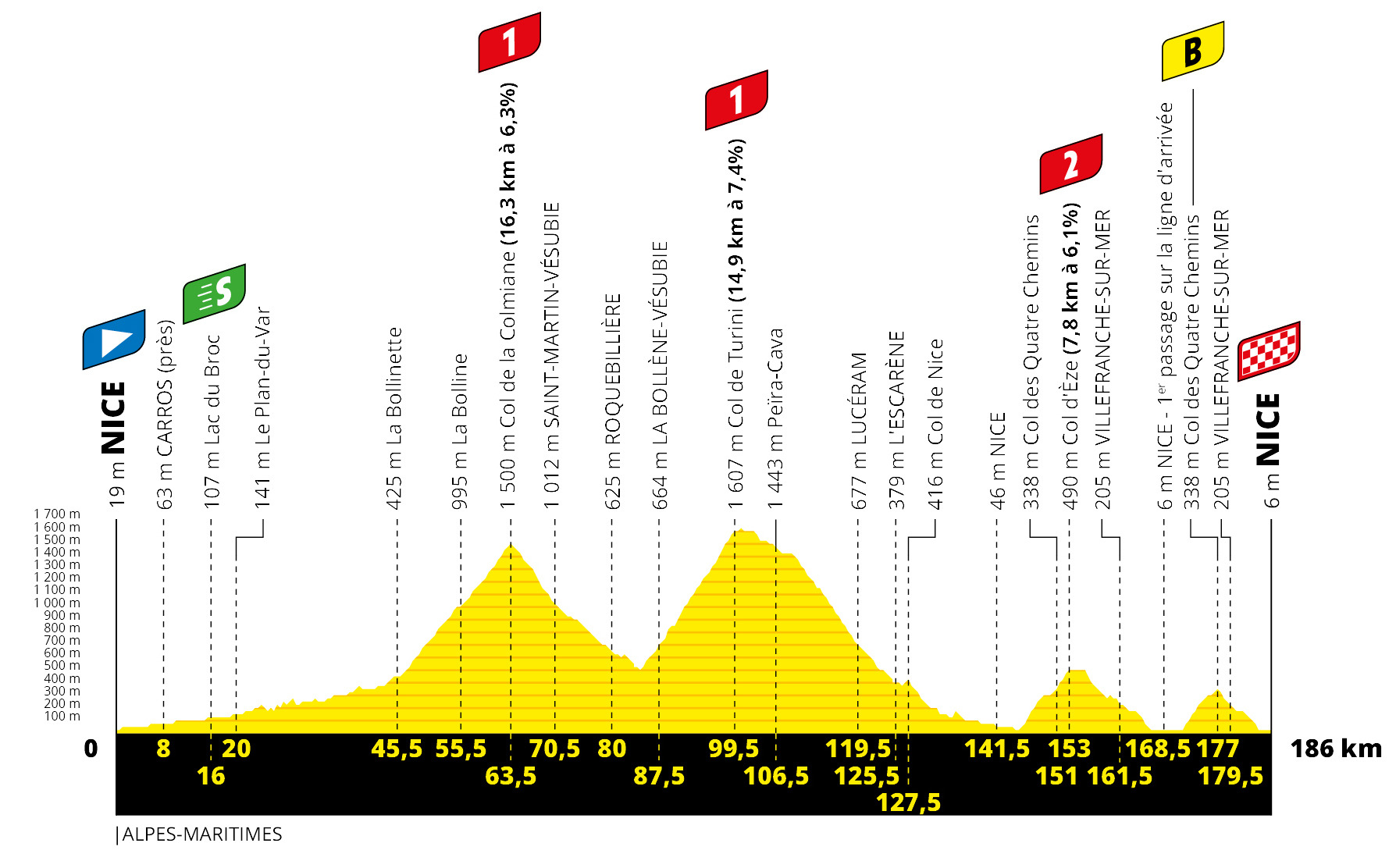
A solid day in the Alpes-Maritimes, with the big climbs of the Colmiane and the Turini mid-stage before a hilly circuit around Nice.
Stage 3 – Monday 31 August

One for the sprinters, they have few chances in this race so their teams have to make today count and they’ll aim to control the race here.
Stage 4 – Tuesday 1 September

The Tour returns to Orcières-Merlette, a ski resort with its place in Tour history thanks to the stage in 1971 where Luis Ocaña got the better of Eddy Merckx for once, and by eight minutes. But no time for nostalgie, it’s only Stage 4 and here’s a summit finish to see the GC contenders in action.
Stage 5 – Wednesday 2 September

Another chance for the sprinters, the late climbs are gentle and on a wide road and if the profile suggests an uphill finish into Privas it’s only the softest of rises.
Stage 6 – Thursday 3 September

Mont Aigoual but to get there the Col de la Lusette which is narrow, rough and steep, it should be selective before the more gentle passage across to the finish.
Stage 7 – Friday 4 September
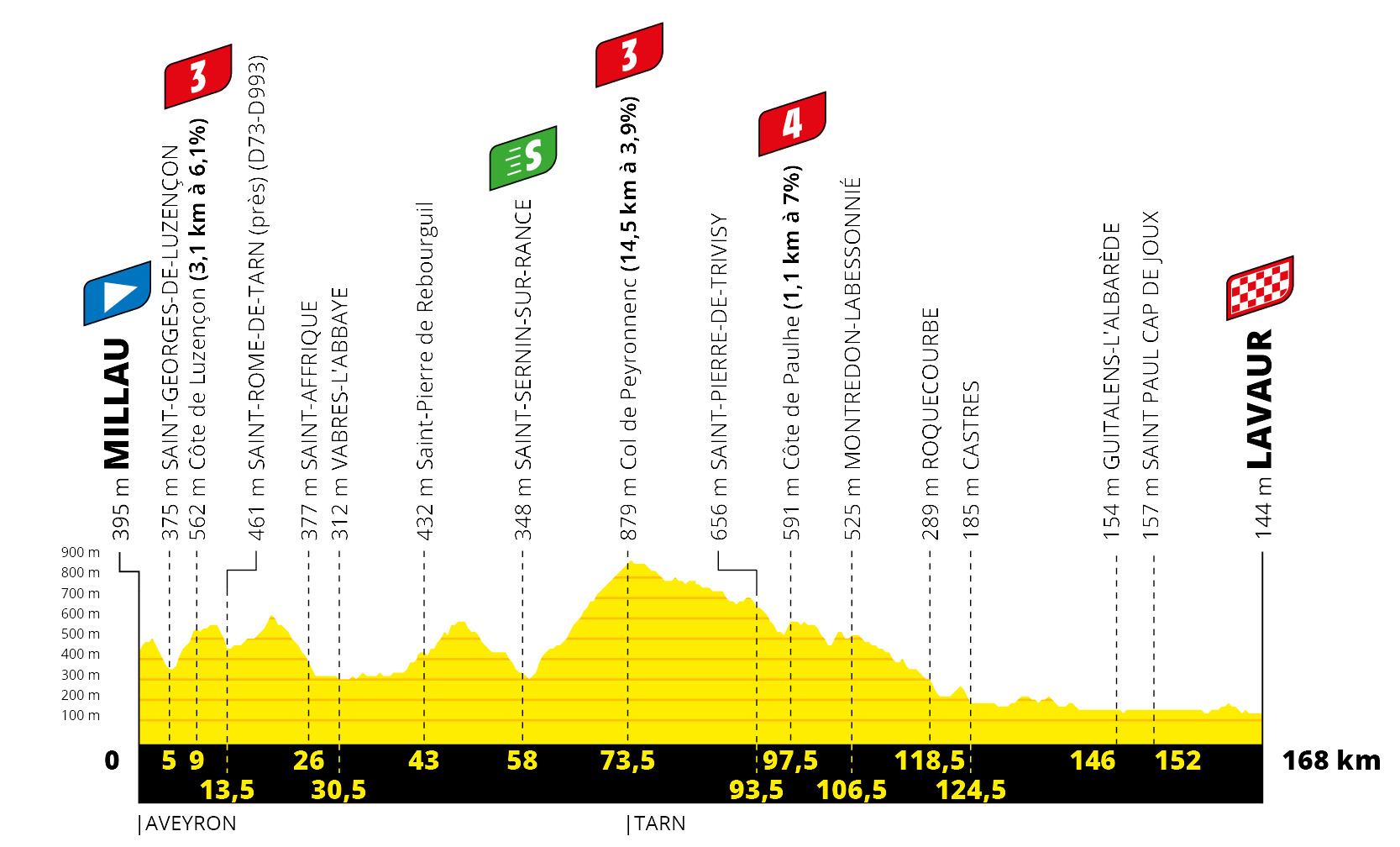
Another chance for the sprinters but watch out for the vent d’Autan, the local wind which caused havoc in last year’s race on the roads to Albi.
Stage 8 – Saturday 5 September

The Pyrenees and three passes which get successively easier but still make for a hard day because of the intensity, it’s only 141km and things should be lively from the start.
Stage 9 – Sunday 6 September
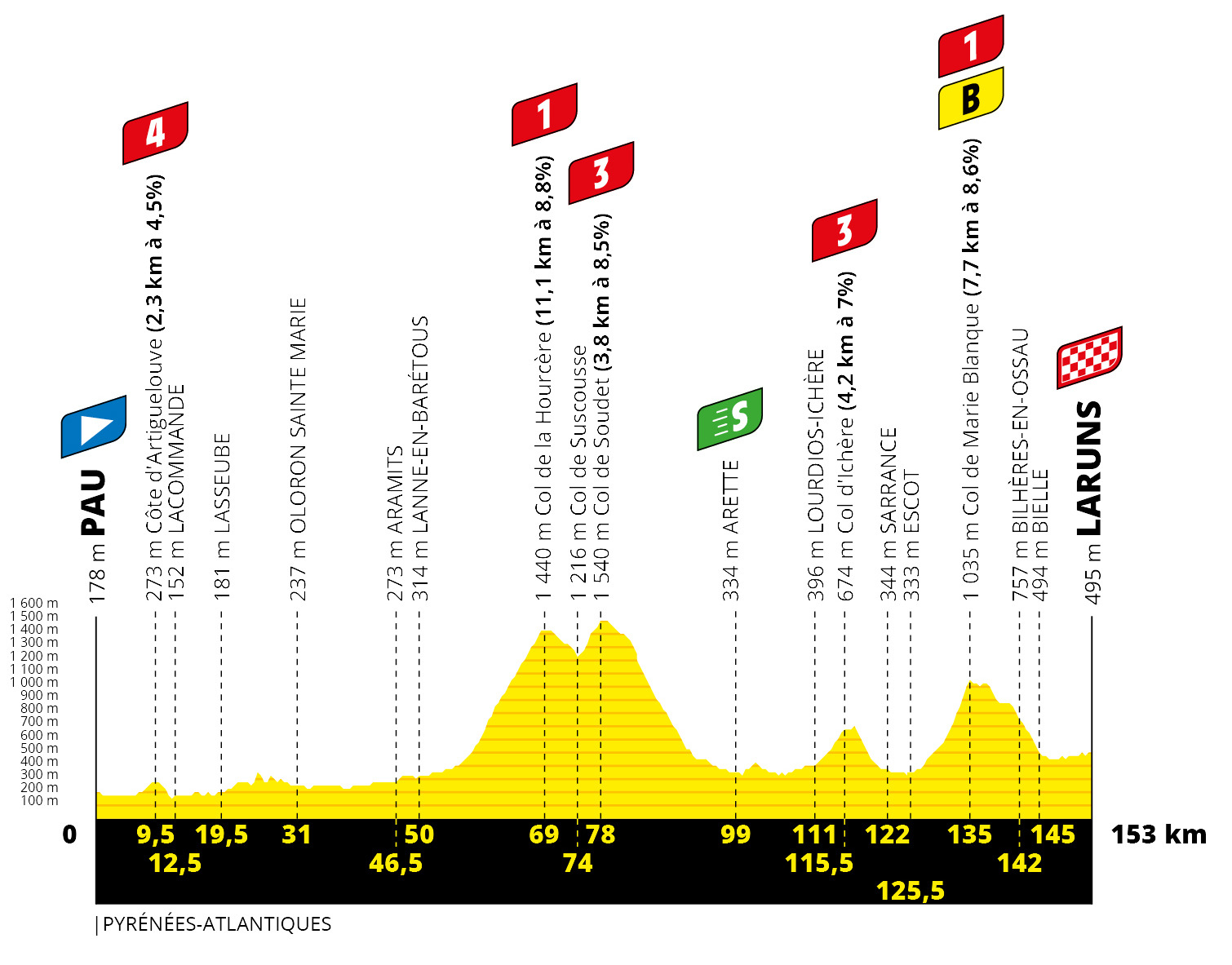
A busy day in the Pyrenees, the Marie Blanque might look small on the profile but the final 4km are 10-12% most of the way so if riders can get a gap here they’ve got a good chance of holding it to the finish.
Stage 10 – Tuesday 8 September

A scenic stage along the Atlantic coast between two islands famous as prized Parisian holiday destinations. An obvious day for the sprinters but watch out for the sea breeze.
Stage 11 – Wednesday 9 September
 The probable siesta stage, unless the weather intervenes there’s not much going on, even the scenery is a bit plain.
The probable siesta stage, unless the weather intervenes there’s not much going on, even the scenery is a bit plain.
Stage 12 – Thursday 10 September
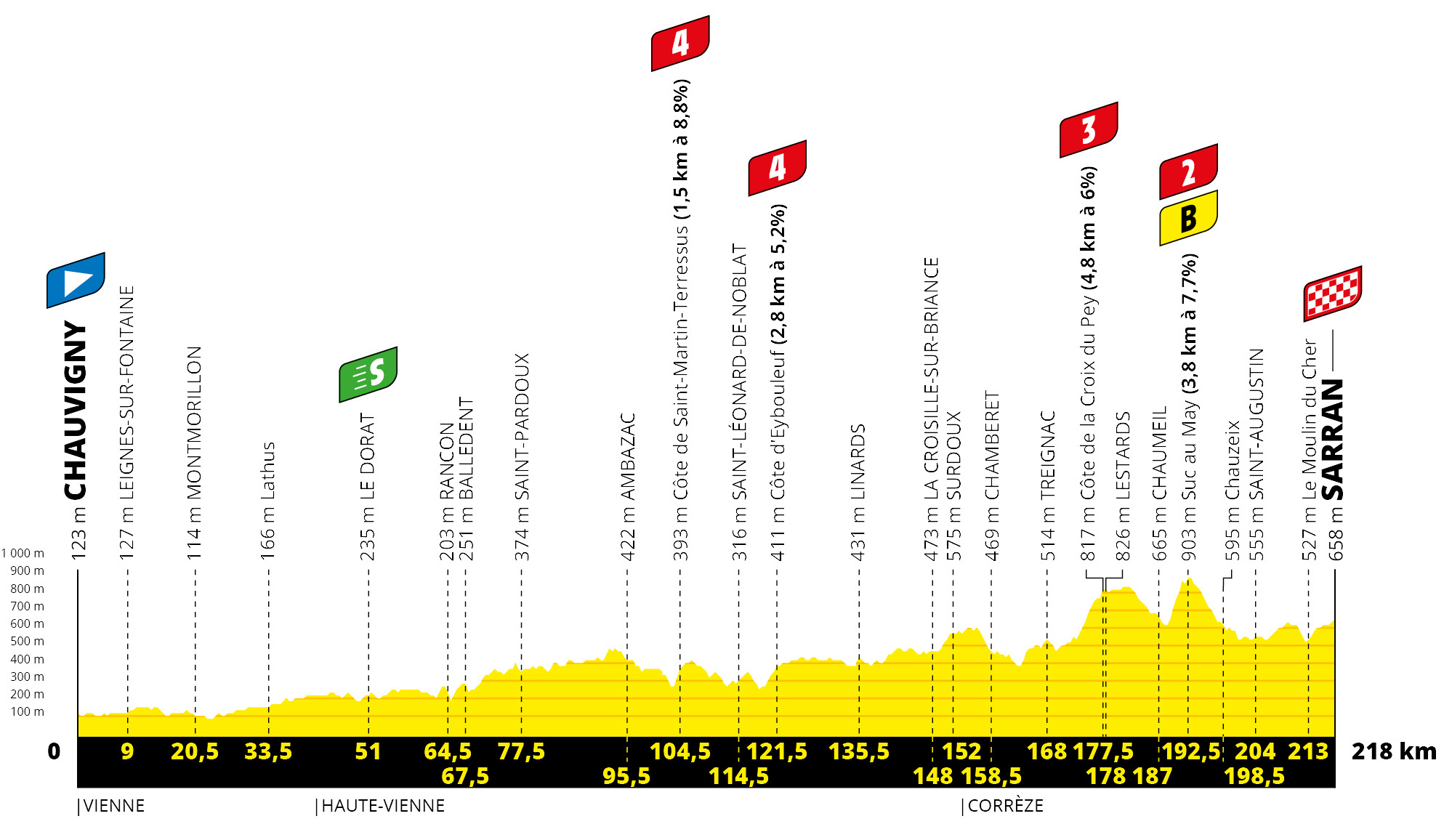
The longest stage of the race and it should allow time to evoke a golden age of cycling with Raymond Poulidor, Jean Ségurel and Antoine Blondin to fill the time. But for the riders it’s a hard stage, the route gets progressively hillier and the Suc-au-May is far harder than the profile suggests, all before an uphill finish in Sarran.
Stage 13 – Friday 11 September

Another long stage and a tough finish in the volcanoes of the Auvergne, climbing the Puy Mary via the Col de Neronne is hard going and the final 2km are at 13%.
Stage 14 – Saturday 12 September

A good day for a breakaway, many will have today marked in their diary because it’s accessible to anyone who goes in the day’s move. Cycling is essentially a rural sport but here’s an urban finish in Lyon and there are some tricky climbs on the approach.
Stage 15 – Sunday 13 September

A really hard stage, what the climbs lack in altitude they make up for in attitude. The “Selle de Fromentel” is the steepest side road up the Grand Colombier with long sections at 14-16% before the steep Col de la Biche and its bone-rattling descent. There’s a short breather before climbing the Grand Colombier from Culoz, via the increasingly famous lacets or hairpins.
Stage 16 – Tuesday 15 September

A quick crossing of the Chartreuse Alps and then it’s across to the Vercors and a finish in Villard-de-lans, the same used in the 2015 Critérium du Dauphiné. It’s a great day for the breakaway.
Stage 17 – Wednesday 16 September
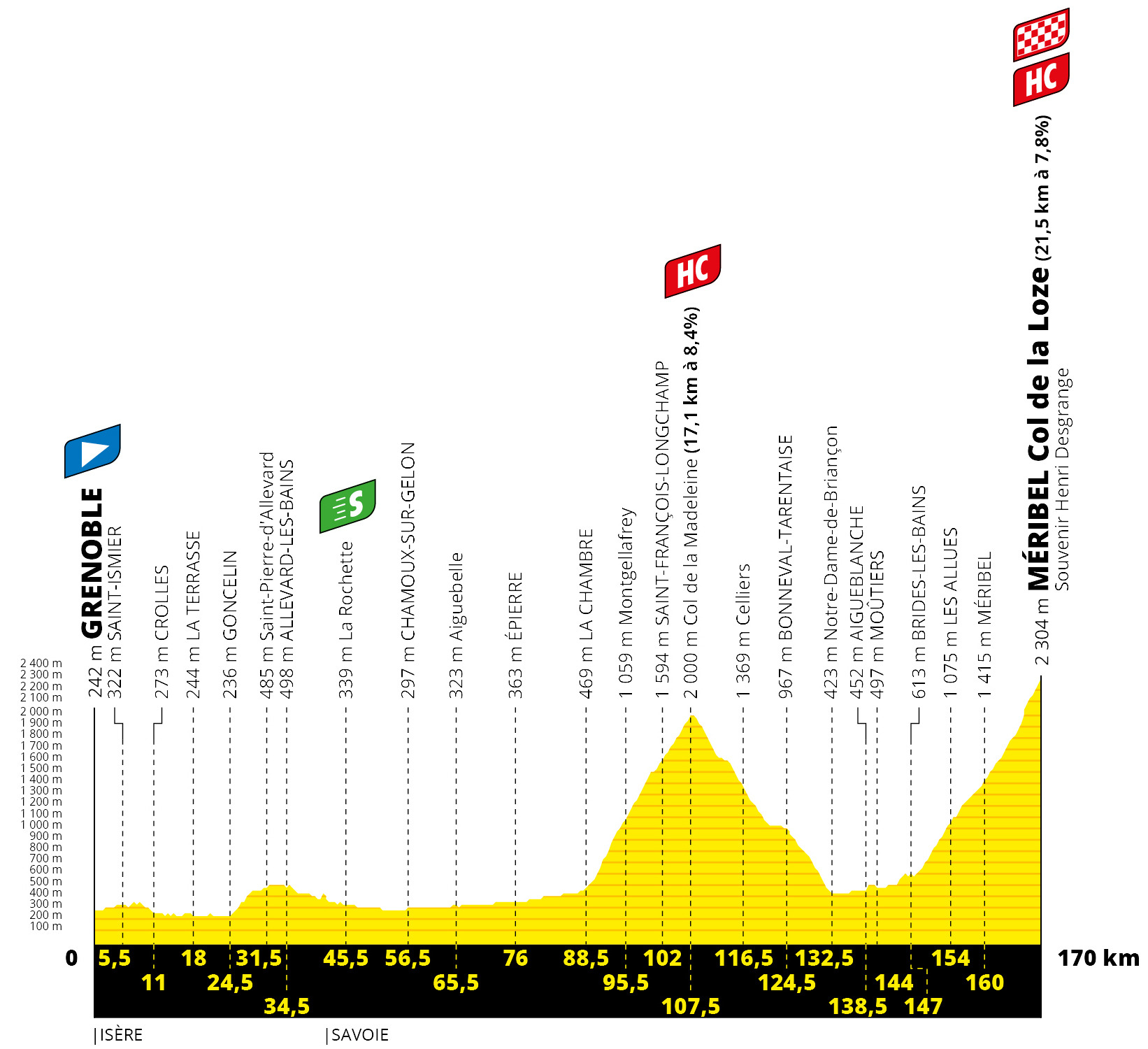
A tough Alpine stage, there’s a dash up the Grésivaudan valley to start the giant Col de la Madeleine and then comes the Col de la Loze. After a difficult ascent to Méribel with plenty of selective 8% sections the race flicks onto the brand new Loze cycle path for a summit finish like nothing else, there are 20% ramps and other nasty surprises.
Stage 18 – Thursday 17 September

A very hard day’s racing with no let up, there’s barely a metre of flat all day. The Saisies and Aravis are regular cols before the climb to the Plateau de Glières. There are steeper climbs, there are longer climbs but few in France are as steep for as long and then it’s the scenic traverse of the plateau across the gravel road before a technical descent, then the big ring climb of the Col des Fleuries on the way to the finish.
Stage 19 – Friday 18 September

A tug of war between the breakaway riders and the sprinters’ teams, there’s a flat finish but the last 60km are on lumpy, exposed roads.
Stage 20 – Saturday 19 September
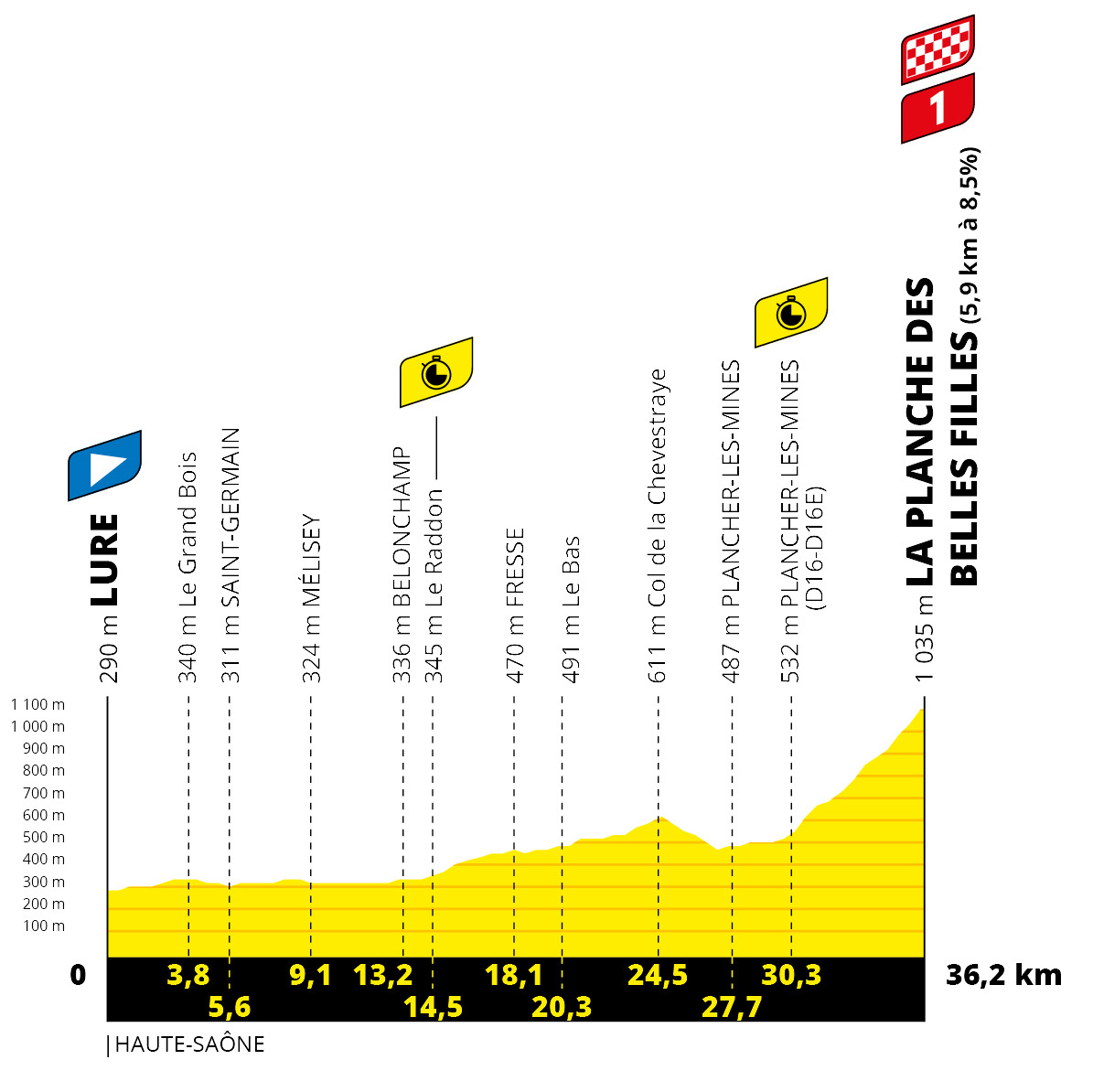
The only time trial of the race and in three parts: a flat section through Mélisey, home of Thibaut Pinot – and where his father Régis is both mayor and undertaker – then a drag up to the Col de la Chevestray and its descent. Finally there’s the awkward climb of the Planche des Belles Filles and this time “just” the normal finish, the riders are spared the gravel extension used in 2019.
Stage 21 – Sunday 20 September

Assuming the race has made it this far then it’s the usual 60km parade that mutates into a 60km criterium and the evening finish on the Champs Elysées.
The Jerseys

Yellow: the most famous one, the maillot jaune, it is awarded to the rider with the shortest overall time for all the stages added together, the rider who has covered the course faster than anyone else. First awarded in 1919, it is yellow because the race was organised by the newspaper L’Auto which was printed on yellow paper. Today it is sponsored by LCL, a bank. There are time bonuses of 10-6-4 seconds for the finish of each stage except the time trials. There are also 8-5-2 seconds at the bonus sprints marked “B” on the profiles above on Stages 2,6,8,9,12,13,16 and 18, typically atop various mountain passes.
Green: the points jersey, which tends to reward the sprinters. Points are awarded at the finish line and at one intermediate point in the stage and the rider with the most points wears the jersey. It is sponsored by Skoda, a car manufacturer
- Flat stages (Stages 1,5,7,10,11,19,21) 50-30-20-18-16-14-12-10-8-7-6-5-4-3 and 2 points for the first 15 riders
- Hilly finish / Medium mountain stages (Stages 2,3,6,12,14,16): 30-25-22-19-17-15-13-11-9-7-6- 5-4-3-2 points
- Mountain Stages + individual TT (Stages 8,9,13,15,17,18) : 20-17-15-13-11- 10-9-8-7-6-5-4-3-2-1 points
- Intermediate sprints: 20-17-15-13-11-10-9-8-7-6-5-4-3-2-1 points
Polka dot: also known as the “King of the Mountains” jersey, points are awarded at the top of categorised climbs and mountain passes, with these graded from the easier 4th category to the hors catégorie climbs which are so hard they are off the scale. In reality these gradings are subjective. Again the rider with the most points wears the jersey. It is sponsored by Leclerc, a supermarket.
- Col de la Loze: 40-30-24-20-16-12-8-4 points for first eight riders
- Hors Catégorie (4 in total): 20-15-12-10-8-6-4-2 points
- Category 1 climbs (15): 10-8-6-4-2-1 points
- Category 2 (9): 5-3-2-1 points
- Category 3 (21): 2-1 points
- Category 4 (15): 1 point
White: for the best young rider, this is awarded on the same basis as the yellow jersey, except the rider must be born after 1 January 1995, ie aged 25 or under. It is sponsored by Krys, a retail chain of opticians
Obviously a rider can’t wear two jerseys at once, they’d get too hot. So if a rider leads several classifications, they take the most prestigious jersey for themselves and the number two ranked rider in the other competition gets to wear the other jersey. For example if a rider has both the yellow jersey and the mountains jersey they’ll wear yellow while whoever is second in the mountains jersey will sport the polka dot jersey. If a rider has all the jerseys the priority yellow, green, polka dot then white.
There’s also a daily “most combative” prize awarded every day to the rider who has attacked the most or tried the hardest. It is a subjective prize and awarded by a jury. The rider gets to stand on the podium after the stage and wear a red race number the next day. There will be a final Supercombatif prize with involvement from the jury and social media. It is sponsored by Antargaz, a bottled gas company.
Time Cuts
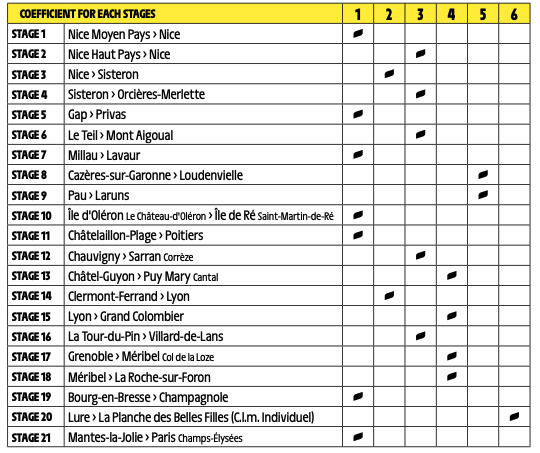
The time cut depends on the stage in question. Look up the stage and its coefficient on the table above and then match it to the listings below. It’s the same tight schedule for the mountains as the last two years, sprinters beware.
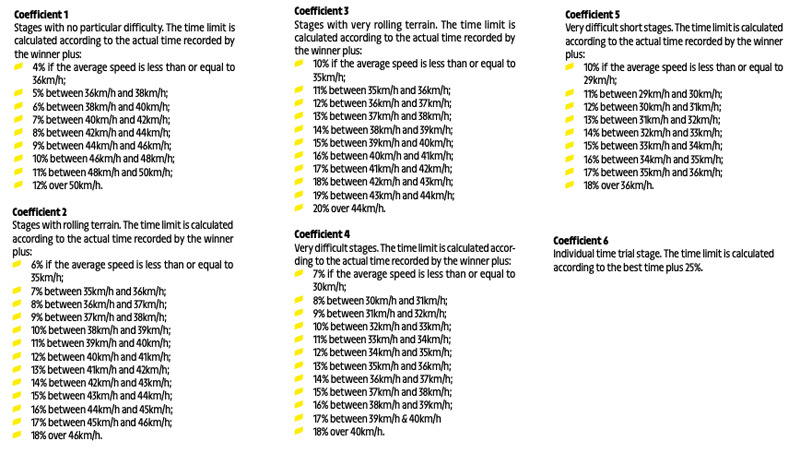
Timekeeping
Normally a one second gap on the finish line is needed to separate groups in a finish but for Stages 1,3,5,7,10,11,14,19 and 21, the likely sprint stages, three seconds is needed for a split in the field. The three kilometre rule doesn’t apply on Stages 4,6,13,15,16,17 and 20.
The unmissable stages
This is the Tour de France and there’s always something to watch but there are some stages that matter more than others. If you need to plan ahead, here are some suggestions for the stages to watch.
- Stage 1: the hectic opener around Nice
- Stage 2: a big day in the hills behind Nice
- Stage 4: the first summit finish
- Stage 6: Mont Aigoual via the tough Col de la Lusette
- Stage 8: the first day in the Pyrenees
- Stage 9: more Pyrenees with the tricky Col de Marie Blanque
- Stage 15: the Grand Colombier summit finish
- Stage 17: the manic Col de la Loze
- Stages 18: the final day in the Alps
- Stage 20: the Planche des Belles Filles time trial
TV Guide
Every stage will be shown live from start to finish. Think of it like the radio, something to have in the background or in a more modern way you can tune in from time to time via your phone in case there’s early action. The daily finish time varies between 5.00pm-5.55pm CEST each day.
The race will be broadcast on a variety of channels around the world. There is no free stream on the internet but you will find a feast of legitimate feeds from local broadcasters and international sources like Eurosport.

The Prizes
- Each day on a normal stage there’s €11,000 for the winner, €5,500 for second place and a decreasing scale down to a modest €300 for 20th place
- For the final overall classification in Paris, first place brings in €500,000 and the Sèvres porcelain “omnisports trophy”, awarded “in the name of the Presidency of the French Republic”. The full breakdown is €500,000 for first place, €200,000 for second place, €100,000 for third place and then €70,000, €50,000, €23,000, €11,500, €7,600, €4,500, €3,800, €3,000, €2,700, €2,500, €2,100, €2,000 €1,500, €1,300, €1,200 and €1,100 for 19th place. €1000 for 20th-160th overall
There are other pots of money available in the race:
- €500 a day to whoever wears the yellow jersey, €300 for the other jersey holders
- €25,000 for the final winner of the green and polka dot jerseys
- €20,000 for the final winner of the white jersey
- There’s also money for the first three in the intermediate sprint each day: €1,500, €1000 and €500
- The climbs have cash too with the first three over an HC climb earning €800, €450 and €300 and lesser sums for lesser climbs
- The highest point in the race sees a prize when on Stage 18 the Henri Desgrange prize is awarded at the top of the Col de la Loze and is worth €5,000
- The “most combative” prize is awarded and worth €2,000 each day, the “Super combative” prize is awarded in Paris and the winner collects €20,000.
- There’s also a team prize with €2,800 awarded each day to the leading team on the overall, €50,000 for the final winners in Paris. Note the team prize is calculated by adding the time of the best three riders each day rather than the best three on GC. For example if a team has riders A, B and C make the winning break one day then their times for the stage are taken and added together. If riders X, Y and Z on the same team go up the road the next day, their times are taken. So it’s the times of a team’s best three riders each day as opposed to the best three riders overall.
The total prize pot is €2,293,900, meagre for an event of this scale but remember that unlike, say tennis or golf, pro cyclists are salaried and prize money instead is incidental. The money is shared around the team (as well as levied and taxed) rather than pocketed by the winner, it’s quite possible the actual prize winner actually collects 5-10% of the headline sum. In addition, every team that starts gets paid €51,243 to cover expenses. And should a squad make it to Paris with six or more riders they stand to collect an additional €1,600 bonus for each rider.

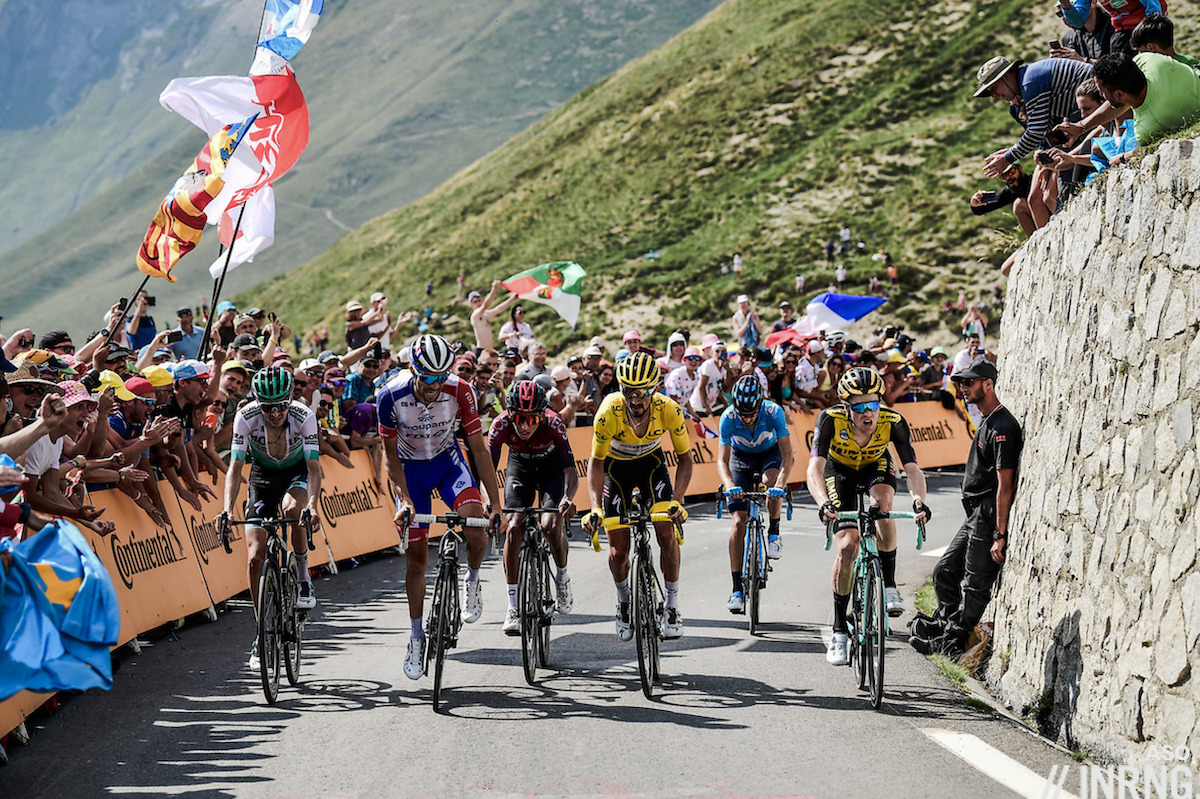
Could very easily be a Vuelta preview. I might put a fiver on Joaquin Rodriguez! All jokes aside the route looks like it should provide interest and some hope for our gallant French heroes Alaphilippe and Pinot.
Is there ever any protest from within regions that get bypassed, saying the Tour is a festival for all of France and not just a series of uphill finishes for tv entertainment?
It’s an endless topic of debate in France, because it’s France and debating is the #1 national sport.
The organizers say they make sure to cross each “departement” (counties) at least once every decade, as opposed to the way it worked ages ago, where the race was literally going around the country, the race path always staying near the borders/coast. But major differences exist, obviously if you’re in the Alps or Pyrenees (or in Paris) you’re likely to witness it every year. Population density explains some of the disparity as well, although the Tour (and cycling in general) has a big reputation as a rural sport in France, contrary to the UK or my country of adoption, Australia.
Local representatives (mayors, etc) also play a role. Start and finish cities have to apply to be selected, there’s a fee to the organizers, and other expenses to accommodate the race. Bretagne and Vendee regions have always been accused of being favored, and pressure from the national federation has been rumored (both are regions with many licensees).
A few years ago, newspaper Le Monde plotted a graph of the number of times the Tour has crossed each departement since inception:
https://www.lemonde.fr/les-decodeurs/article/2017/06/29/combien-de-fois-le-tour-de-france-a-t-il-traverse-votre-departement_5153251_4355770.html
Good comment, it covers plenty. The Tour has plenty of offers to visit, Christian Prudhomme says at any time he can pick between 300 towns. I think we’re likely to see more of the Tour in the south to hunt out the hillier roads or if the race does go north we’ll see the climb at Mûr de Bretagne, the Roubaix cobbles etc.
The Tour de Sud France. It’s an increasingly hilly parcours they choose. We’ll probably see plenty of breakaway action as a result. But that doesn’t always equal excitement.
Watching Demare win Wollonie, and Sagan struggle off the back at the Dauphine made me think that we may witness the passing of the guard in respect of the green jersey, but looking at this route I doubt either of them will be thrilled with their prospects. The physical make up of the green jersey winner might be a little more grimpeur than sprinter (a la Giro) which in some ways will be a shame.
WVA has to be favourite for Green on form, though it depends how much freedom Jumbo-Visma allow him. Demare always seems to struggle with the hills in the third week. Alaphilippe may be a decent shout if he’s distanced from the yellow jersey early on because there are a lot of stages he could go after if he was far enough off the lead. With the amount of medium mountain stages and breakaway opportunities the mountains jersey could be a good fight between De Gednt, Barguil and potentially Alaphilippe again.
Demare isn’t going to the Tour.
Whilst it would be nice to see Van Aert have a go at Green, what we saw in the Dauphine suggests he will primarily be on team duty as an important component of both the flat and even the mountain trains.
I’m not sure that he’d be given rein to contest the intermediates too.
Which all sort of says Peter Sagan again if he starts?
Gilbert for green? He came reasonably close in 2011, and this relatively sprintless Tour could suit him.
Is Sagan riding? I’d assumed he wasn’t as he’s doing the Giro (still can’t believe he’s forgoing most of the Monuments when any other year he could ride the Giro and still do those – is their money involved; and does he really need it?).
I wonder if Sunweb are regretting not bringing Michael Matthews? Sagan doesn’t seem his usual self and I suspect WVA will be on guard duty.
Weirdest categorisations of climbs I’ve ever seen. Even worse than having Port de Pailhères as category 1 (as that was a one-off in 2003).
Oh, I know it’s often not as exciting as you’d hoped but I am looking forward to the Tour after being cycling starved for so long this year.
Looking forward to Stage 6 and hoping Mont Aigoual throws up some surprises. An ambush attack that day from one of the second tier favourites to unsettle the probable winner, and the mountain itself is capable of throwing four seasons in one day at the race. Can be thirty odd degrees in the valley and cold and wet as the coldest and wettest day in winter
Or howling wind at the top too, Ventoux-style too.
I did Augial from the rear in 2017 and rode down to Le Vigan the same way they go up.
That road surface was possibly the worst i have ever seen in France – and its steep too. Could very well have an impact if the road have not been resurfaced. I’d rather go up or down if it had been on gravel.
I dont think the wind will have much effect the approach to Augial from that side is a bit sheltered and they are likely to have a tailwind. (its not like the rear side approach to Signal de Lure which is wide upen, against the wind and unsheltered)
This race looks like a balancing act, unless you want to grab yellow from day 1. In fact it might work for some less favoured rider (like Alaphilippe last year) to seize the jersey and hope the main contenders knock themselves out through attrition. It’s going to be hard to control the race without strong domestiques.
if only Carapaz hadn’t gone and won that pesky Giro, he could have sneaked under the radar here…
I wonder if the new technique could be to take the yellow jersey ASAP and keep it. That way any sudden race cancellation would annul any benefits of saving energy. The creeping escalation of cases in France sadly means that this could be a legitimate tactic, especially with the tricky stages round Nice in the hills and medium mountains.
In the past Sky have been happy to take the lead and defend, using their strong team to steamroller the race. That won’t be so easy now and besides they or Jumbo-Visma might not want the jersey early either. Cancelling the race could happen, but there would be several warnings first, local restrictions first and so on.
Rather disappointing to see from stage 19 that the grandiosely named “Col de France” is actually just a tiny hill !
Rode it the other day for recon and likewise was expecting something special, a national monument and an explainer… but nothing, just the plain sign at the top. It’s sneaky having an uncategorised climb at the start but it shouldn’t be too much of a surprise to the peloton, they did it in the Tour de l’Ain the other day.
No border there, but considering the location, an earlier border may well have birthed the name – the border between the kingdoms of Burgundy (Arles) in the East, and the French duchy of Burgundy, to the West, in the early Middle Ages.
Really, all I want is an open race (and a race that finishes – let’s hope the crowds stay away), but I’d also like to see Pinot attack on early stages – before Roglic and Bernal get over their respective issues, and before Dumoulin’s form improves.
Pinot’s tactic is never going to be a long campaign in yellow. His team just could never defend the jersey for a sustained period. The Dauphine about proved this, though I wish him and his French colleagues Bon chance.
Good point, RQS. However, I’ve always believed that a team do not have to take on the supposed duties of being in yellow. You have to chase down competitors for GC (which is often down to individuals at the top of mountains, after teams are long gone); you do not have to chase down breakaways that don’t affect your GC prospects. You simply refuse to do it on a day when there is no-one dangerous in the break, and if the other teams refuse to chase the break you lose the yellow jersey to a ‘no-hoper’ and no longer have to ‘defend’ it. Whatever the result the peloton quickly learns that you aren’t going to ride on the front day-in day-out.
Having said that, Pinot’s form hasn’t been scintillating – although good-ish – so early attacks might not work out anyway. But this is a better chance for him than most years – there being no utterly dominant favourite (Roglic is not a proven repeat GT winner, and is carrying an injury) – and there’s no point in Pinot coming second: might as well go for it and come ninth.
That maybe true (for Pinot) personally but I feel his team/sponsors who are paying his salary would rather have 2nd than 9th
Yeah, but I think he has to ignore that. Also, his team aren’t going to sack him, no matter what. Plus the risk is worth the reward, probably even to the sponsors.
Sort of agree but he’s going to need time in the bank for the TT on the penultimate stage. They can always let a break go and try and restrict their time that they need to defend the yellow themselves.
All hypothetical, it’s going to take a monster performance to beat the JV juggernaut.
Depends on whom. I’d expect Roglic or Martínez to be faster than Pinot on the TT (even though those are his home roads) but I expect Pinot would be on par with Bernal or Buchmann, and probably faster than Landa or Quintana.
That’s assuming optimal freshness, though. On stage 20, who knows.
Don’t know about you but I can’t see Landa or Quintana being the leading lights by stage 20. Buchmann, Pogacar and particularly Dumoulin more likely I would think.
Agree, pinot is pretty handy on the TT bike and it’s uphill, on home roads. If he doesn’t choke he can do really well there. But Dumoulin and Roglic will be hard to beat
So the juggernaut label has officially transferred from Ineos to JV? 😉 I wouldn’t think that Ineos will be too upset about that. Carapaz and Amador are both seriously strong on top form, but more so, Ineos are also so good at limiting loses when they’re under pressure and have the experience of 9 grand tour wins. JV have one Vuelta and are less proven there. I’m still a JV believer, just think we’re in for a really close fight
Jumbonaut? 😁
Jumbots🤔
Impressive hindi portmanteau 😉
Just seen that Adam Yates has signed for INEOS. No mention of Simon who I guess remains at Mitchelton-Scott. My feelings on this are a bit confused. It’ll be nice to have another top Brit in an “British team”. But will he have a lead role? It seems a big gamble on his part. But he will be out of his brothers shadow.
Simon has signed up for another two years at Mitchelton Scott. I guess Adam will get a better salary at Ineos but less freedom to express himself
Given his GT results in recent years, and that MS apparently have little faith in him as a GC contender (which seems a bit odd after 2016, but not by his later results), I very much doubt he’ll walk into a leader’s role at Ineos.
I’m not surprised by this move. I thought he may well have been unhappy with MS’s lack of faith in him, and by going to Ineos he gets to see if he can be a GT rider in a couple of years, if he proves himself as a domestique. He hasn’t shone as a one-day rider either, so maybe it’s a good move. (Alternatively, he knows he doesn’t have it, and he’s gone for a bigger salary, which would be fair enough.)
It’s a good point that MTS might not have great faith in A. Yates for GC, although to be fair it has been a while since he had a good performance in a 3-week tour. It might not be a coincidence that they announced his signing only a couple days after MTS announced their Tour de France team, claiming they’d go for stage wins with no ambition in the overall.
Adam Yates was great in 2016 but also served a doping ban in the same year. Since then he’s not served any more doping bans but neither has he really excelled in races in the way 2016 results led you to believe he would.
Think you’ve got Adam confused with Simon.
I am! Very embarrassing. Will teach me to google next time before I post. I’ll put myself isolation for a bit as penance.
I did suggest this move back to a more recognised British core in the Ineos article the other day before someone started babbling on about pubs and BMW chain drives 🤣
The route looks a bit harder than normal.
Although there is a few hilly / mountain stages where the finish is a fair way from the last KOM and often stages like that fizzle out because nobody attacks.
Stage 18 looks like it could turn the green jersey on its head by eliminating people. Or at least having there points docked if the large group comes in outside the time.
I think the best stages are the close to 100km mountain stages so i am disappointed there is not one.
I don’t think WVA is a green jersey contender unless JV have a disaster near day 1 and lose all the GC contenders.
I still see 8 chances for the sprinters here. The sprinters that start are not the Groenewegens but rather the Sagan, Trentins, Colbrellies an also Bennett knows his way around a column or two.
I would still say more than enough sprintchances.
Que la course commence !
Can someone ask Raphael geminiani what he thinks of this course?
I think it would be more accurate to say Pinot is wildly inconsistent in TTs
Sorry, that was in response to Tevhan
Thanks so much for this preview of the stages – invaluable to me as I’ll be watching the race with a 10-day delay.
Looks a fantastic route (my only gripe would be that a TT is not the most exciting way to end a race): great to see challenging early stages so that the GC race should begin right from the start.
You’ll be several times further from Earth than Voyager 1?
That, or on holiday with a partner who doesn’t want to spend her time watching me watch cycling. Thus I’ll be watching videos on Eurosport Player (thank God for that function).
Haha. I feel your pain! Will be very hard to avoid spoilers. Is the plan to keep the 10 day delay to the finish or after the holiday will you binge massively to catch up in order to watch live stages as they happen?
I might try to catch up, but I doubt I’ll manage if I’m watching the stages properly. I’ve done this before, and it’s one of so many ways that cycling is superior to football: you could never avoid the result of the World Cup, and then go back and watch it. Are you in a similar situation then?
1989
Looking forward to this race now, in fact, the next couple of months could be quite a unique and epic period of racing. After all of the nonsense of this year it will certainly add some shine to 2020 and hey ho, a change is as good as a rest!
Agree. It’s unprecedented territory we’re in. Training schedules are in ribbons. A condensed events calendar has teams scrambling to knit together rosters to be competitive and prioritising competitions in ways which have had them thinking on their feet. All these things happen during a normal season, but never in such an intense way. Teams alive to the opportunities will reap huge rewards and others may have a 2020 to forget. It’s all to play for.
Not convinced about the ‘tug of war’ on stage 19. I imagine for most of the sprinters who actually turn up this will be an 11 stage race at most. Solidly for the breakaway, that one, I would think.
Just to add some spice to Stage 1, it is worth keeping an eye on the weather forecast for Saturday. At the moment showers are forecast with gusts of up to 45 kph for the afternoon. I also wonder whether with the change to the timing of the Grand Tours, the weather will have a different influence than usual – although the unexpected can always occur eg TDF 2019.
Yes, I looked up the weather forecast this morning and it could be windy, gusty even. So something to keep an eye on as it’ll be a nervous stage if it’s just warm and sunny.
Doesnt look like it will be a straight forward bunch kick to me?
Think a few riders/teams will be keen to really mix it up….
I have been looking at Windy, can only see gusts to 19kts (35kph) on Saturday from 2pm onwards and coming from the SW.
Doesn’t look like it will trouble the peloton much…
Just came back from a holiday on the Ile De Re where the Tour is finishing on stage 9.
First thing we noticed was new tarmac on the finishing straight outside St Martin de Re. There was also two roadside signs flagging that this was the finishing line of a TDF Etape. Of course I got the kids in the back of the car (and me!) throwing their arms in the air a la Cav each time we drove that way.
I did a bit of cycling on the island, and it is prettty exposed when the wind is blowing: the third biggest bridge in France between the mainland and the island, and than some open-ish roads to St Martin de Re.
We were speculating about helicopter shots: my guess for the trifecta (well, Quad-fecta) would be the old Vauban fortifications around St Martin (a bit problematic as part of them are a high security prison blurred out on google maps so they may be a bit sniffy about helicopters overhead), the lighthouse at St Clement, the beach at Rivedoux and the salt marshes around Loix and Ars.
By the way, the whole island is flat with safe cycling paths everywhere and is a great holiday destination for families who like to cycle together. Even my wife got on a dutch bike; albeit electric. I stuck to the trusty CAAD10!
Lots of fresh tarmac over France for the route, I sometimes wonder if you can spot the Tour route from space because of the new blacktop. Lots of decorations along the route too, it’s the biggest thing to happen to thousands of villages en route so rusty bikes have been dragged out of barns and painted yellow etc… and some have been out since spring and are rusting again.
Lol. Plenty of bikes on Ile De Re. A winter population of c20,000 goes to 220,000 during the summary, and they all ride dutch bikes.
BTW, thanks for the work you put in. I’ve been reading you gratis since – gosh – at least 2014. A true public servant in the true sense of the words. 👍
“This is an anti-siesta Tour course”
Would this explain le monde not having a 2020 version of their siesta guide? (not that i can see anyway)
https://www.lemonde.fr/les-decodeurs/article/2019/07/06/tour-de-france-2019-etape-par-etape-quel-est-le-meilleur-moment-pour-faire-la-sieste_5486270_4355770.html
From memory this usually comes out in time for the Tour’s opening stages but we’ll see, their usual fun coverage of the Tour via the “En Danseuse” blog could be different after staff changes inside the paper.
Just a thought. It’s getting a bit tiresome reading all these JV train stories and how they’re going to shred the Tour to pieces. Now I know the media like to hype a team to knock them down and they always want to build a rivalry but where is the balance? With Froome and Thomas dropped, the Ineos team looks formidably strong now that Amador and Carapaz are included. They may need to alter their tactics a bit, though, because attacking in the final few kms isn’t likely to work as Roglic will outpace/outsprint Bernal every time.
As we saw in the Tour de l’Ain and the Dauphiné both teams have strong squads but they also used up their last riders to leave their team leaders by themselves in the final phase of the race, eg Bernal alone on the Col de Porte, Roglič with nobody in St. Martin de Belleville. Put another way it won’t be easy for a second tier climber to jump away early on a summit finish but by the time the finish is near those without such strong teams – think Quintana, Pinot, Buchmann, Martinez, Pogačar, Porte, Landa etc etc – might have some space.
Thanks for the guide, but can you please not call stages under 200km “long”? It’s ridiculous, really.